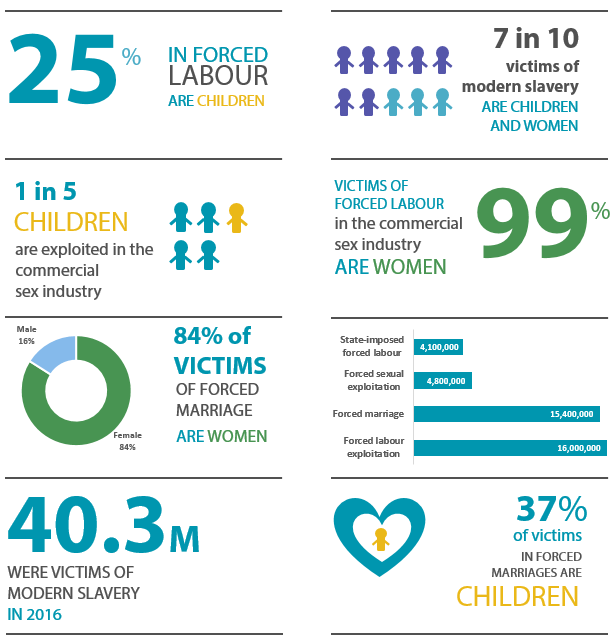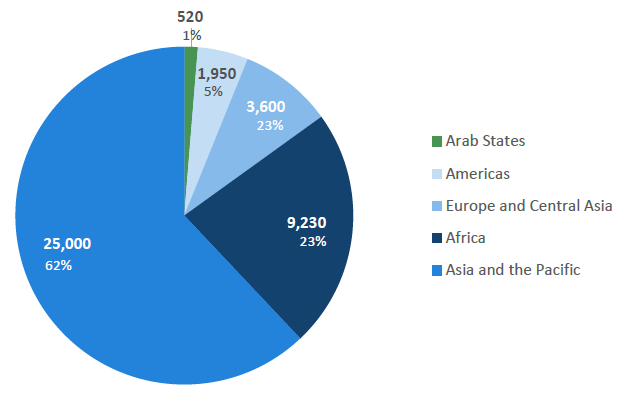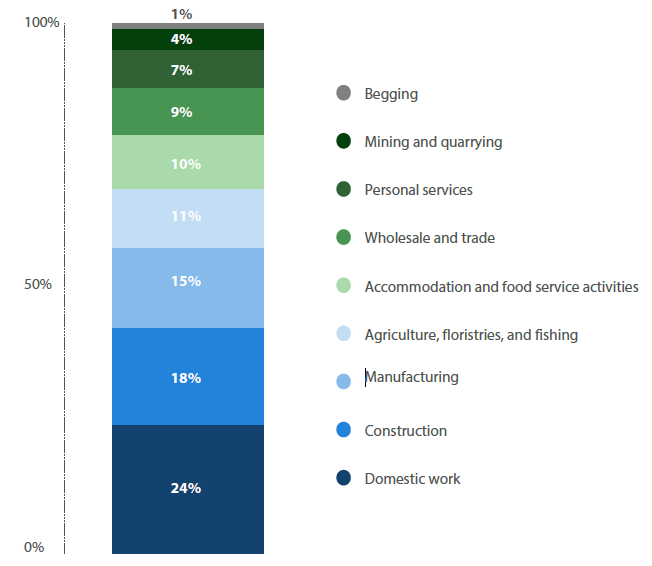Summary
Nikko AM strongly believes that considering environmental, social and governance (ESG) factors is inherent to long-term corporate value creation, and contributes to the realisation of our company’s sustainable growth. In November 2018, Australia’s Modern Slavery Bill 2018 was passed in parliament, heralding a shift in the way corporates identify and report on modern slavery risks in their operations and supply chains. We welcome the introduction of the legislation; seeing it as a positive step towards greater transparency and social accountability for Australian corporations.
What is modern slavery?
While there is no globally agreed definition of ‘modern slavery’, according to the World Economic Forum modern slavery can take many forms, including human trafficking, forced and bonded labour, sexual exploitation, domestic servitude, early and forced marriage, debt bondage and organ trafficking.
Forced Labour, which constitutes the majority of modern slavery is defined by the International Labour Organisation (ILO) Forced Labour Convention, 1930 (No. 29) as “all work or service which is extracted from any person under the threat of penalty and for which the person has not offered himself or herself voluntarily”.
The identifying feature is the involuntary aspect of taking the job or acceptance of the working conditions and the application of a penalty or threat of a penalty to prevent an individual from leaving a situation or otherwise to compel work. Coercion can take many forms from physical or sexual violence to more subtle means such as withholding wages, retaining identity documents and threats of denunciation to authorities.
Understanding the scale of the problem
The ILO, which is a specialist agency of the United Nations, reported in 2017 that an estimated 40.3m people were victims of modern slavery in 2016, amassing around USD150b of illicit profits per year. (The ILO notes that due to limitations of their methodology and data, they believe that these estimated numbers are conservative.)
Of the c40m estimated enslaved individuals, c25m are in forced labour and c15m are in forced marriage to which they had not consented. This includes providing labour and sexual services under the guise of marriage.
Modern slavery affects both adults and children, but disproportionately affects women and children.
Figure 1 The victims of modern slavery

Source: Data sourced from ILO and The Victims of Modern Slavery report by Statisa, 19 September 2017
The duration of each individual’s experience in slavery varies widely from days to years. The ILO estimates that the average duration of forced labour exploitations was 20 months; for victims of sexual exploitation it was 23 months.
Prevalence by region
The 2017 Global Estimates of Modern Slavery report issued by the ILO, in collaboration with the Walk Free Foundation and in partnership with the International Organisation for Migration (IOM), reveals that a staggering 62% of all victims of modern slavery worldwide were located in the Asia-Pacific region. This was followed by the Africa region (23%), Europe and Central Asia (9%), the Americas (5%) and the Arab States (1%).
Chart 2 Regional distribution of modern slavery – number (in thousands)

Source: Data sourced from ILO and The Victims of Modern Slavery report by Statisa, 19 September 2017
Prevalence by industry
The ILO’s research identified that a range of industries were using modern slavery and forced labour practices. The greatest incidence was found in domestic work, by virtue of forced marriage. In commercial sectors, the industries with the largest exposures were construction, manufacturing, agriculture, food services, accommodation services and mining and quarrying.

Source: Data sourced from Global Estimates of Modern Slavery, Alliance 8.7, International Labour Organization and Walk Free Foundation, 2017
Why are we talking about it?
Why is this an issue for Australia (and other developed economies) with strong labour and child protection laws? In summary, because global supply chains stretch into regions where such protections either don’t exist or aren’t enforced and labour rights and, in some instances, human rights are routinely abused.
The Global Slavery Index suggests that two-thirds of modern slavery occurs in the Asia-Pacific region, where many Australian supply chains extend. As such, Australian companies with operations in, or who are sourcing from the Asia-Pacific have a potential exposure to modern slavery practices.
Government action, investor attention
Despite incredibly high numbers of affected people, and an obvious moral and ethical opposition to such practices, the efforts of governments and their willingness to become involved in eradicating such practices is surprisingly limited.
Following the extensive research conducted by the ILO into modern slavery, the issue is now on the agenda of only a handful of governments. One government notable for its inaction is the US, where Congress has failed on four occasions since 2014 to pass a bill seeking transparency on supply chains. That said, California has passed legislation requiring transparency in supply chains and in 2015 the Obama administration required companies with government contracts to certify that they had done their due diligence in confronting and remediating human trafficking and slavery in their extended supply chains.
Governments that have taken action include the UK, France, Australia and New Zealand, all of which have introduced legislation requiring companies of a certain size to assess their supply chain for the risk of exposure to modern slavery practices, report on their exposure as well as the action taken to address those risks.
In Australia, the Modern Slavery Act 2018 (Cth) requires:
-Businesses with revenues over $100m to report annually on the:
- risks of modern slavery in their operations and supply chains
- action they have taken to assess and address those risks
- effectiveness of their response.
-This disclosure must be approved by the board of directors.
-First statements are due 31 December, 2020.
A controversial omission from the Australian Act, as well as the UK Modern Slavery Act 2015, which is comparable to the Australian Act, is any form of penalty for non-compliance.
Given the lack of penalties, it would appear that these two governments are relying upon consumer backlash and investor intervention to force companies to identify and remove these unethical and immoral practices from their business operations, including third party supply chains.
Nikko AM Australian Equities response
Our approach to investment is centred upon fundamental analysis of a company’s business and the industry within which it operates. This includes an assessment of all opportunities and risks that will impact a company’s profitability and future prospects. The range of opportunities and risks include ESG factors, as these factors have the potential to have a material impact on a company’s earnings and valuation.
Clearly, a company found to be breaching international labour laws or that fails to protect against labour exploitation within its own operations or in its supply chains could have meaningful consequences, including:
- Reputational damage impacting revenues and requiring investment in marketing to remedy. One recent example of the impact that a breach can have is Top Glove. The UK’s National Health Service conducted a review of its £35m annual spend on gloves following awareness of unethical treatment of foreign workers by Top Glove in its Malaysian factories.
- Government/regulatory intervention in a business found in breach. A company found to be employing unethical labour practices will likely be exposed to additional regulatory scrutiny. This will clearly add cost to the compliance function and create significant distractions for the business.
- Fines and penalties are a potential additional risk, albeit will currently be limited to fines within the jurisdiction of breach. The Australian modern slavery legislation contains no scope for financial penalties.
- Liabilities for compensation. In instances where the modern slavery breach has had physical, emotional or financial consequences for the labour force, a company may be exposed to compensation of the impacted individuals.
As with all ESG considerations, we incorporate an assessment of a company’s risks as part of our company research.
In respect to modern slavery, our approach currently is to identify companies at risk and thereafter engage with management and boards regarding their approach in managing this risk. Australian companies are moving quickly down the path to assess the risk and take appropriate risk management actions for modern slavery. Increased monitoring and independent auditing will likely form part of the solution.
Nikko AM is of the view that companies will need to have a deeper understanding of their supply chains and the labour management practices of their key suppliers. Ideally, each company’s expectations for staff and third-party suppliers will be formalised in a Corporate Responsibility Policy, which includes a commitment to ethical behaviour and practices. In addition, it is likely that to adequately address this issue, companies will need to provide training for their staff, such that employees become better equipped to understand, identify and report instance of modern slavery. Further, it may be necessary to adjust the KPIs of sourcing and procurement teams to reflect the importance of this issue and ensure the requisite effort is applied in monitoring and managing this risk factor.
Our engagement with company boards and management teams will therefore include discussions around the progress companies are making in enacting these necessary changes. Essentially we will be seeking proof-points that will provide us with comfort that companies are taking action on these issues.


